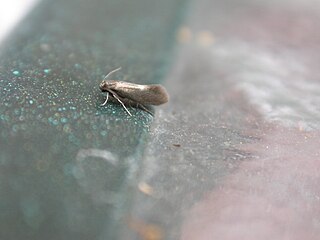| Hoplophanes chalcophaedra | |
|---|---|
| Scientific classification | |
| Kingdom: | Animalia |
| Clade: | Euarthropoda |
| Class: | Insecta |
| Order: | Lepidoptera |
| Family: | Heliozelidae |
| Genus: | Hoplophanes |
| Species: | H. chalcophaedra |
| Binomial name | |
| Hoplophanes chalcophaedra Turner, 1923 | |
Hoplophanes chalcophaedra is a moth of the family Heliozelidae. It was described by Alfred Jefferis Turner in 1923. [1] It is found in New South Wales. [2]

Moths comprise a group of insects related to butterflies, belonging to the order Lepidoptera. Most lepidopterans are moths, and there are thought to be approximately 160,000 species of moth, many of which have yet to be described. Most species of moth are nocturnal, but there are also crepuscular and diurnal species.

A family of primitive monotrysian moths in the order Lepidoptera, Heliozelidae are small, metallic day-flying moths with shiny smooth heads. In Europe the small adult moths are seldom noticed as they fly quite early in the spring. The larvae are leaf miners and the vacated leaf mines are distinctive because the larva leaves a large hole at the end.

Alfred Jefferis Turner was a pediatrician and noted amateur entomologist. He was the son of missionary Frederick Storrs-Turner. He introduced the use of diphtheria antitoxin to Australia in 1895. He was known by the nickname "Gentle Annie".